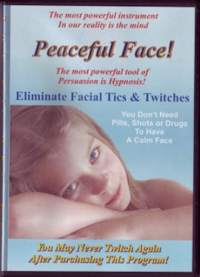
|
|
Banish Facial Tics With NLP
Click here to email this
page to a friend. |
||
|
As many as one in four
children suffer from the embarrassing annoyance of facial tics. This condition,
which can best be described as a repeatedly occurring spasm affecting the
muscles of both the eyes and the face. The exact cause is often unknown, but
research has demonstrated a strong link between stressors and an increase in
severity of symptoms. Another possible cause of
tics is deficiencies in essential vitamins or minerals, such as magnesium. In
some cases, facial tics are symptoms of nervous system disorders, including
Tourette syndrome, a condition caused by a dysfunction of the nervous system.
Tourette syndrome is thought to have a genetic component as well. Some examples of a facial
tic include rapid eye movements or eye blinking, squinting, mouth or nose
wrinkling, twitching, grunting, mouth twitches, facial grimacing, facial
twitches, and throat clearing. The condition often begins in childhood, and may
last for only a few weeks or for several years. Sometimes, the condition
persists into adulthood. Facial tics can perpetuate
and increase anxiety levels in a child whose stress levels are already high
because of the disorder itself. Other children can be very cruel, making fun of
the child's problem. Worse, teachers who lack understanding and fail to assist
fellow classmates to understand and assist the child in overcoming his
difficulty can have a devastating impact on a child's self-esteem. The problem, however, is not
limited to the afflicted child. Adults who must cope with a facial
tic find this extremely difficult to manage. These individuals often face
significant social difficulties. In some cases, a person can learn to recognize
the onset and master the urge that results in the facial tic. Even this,
however, can become emotionally and physically draining. Low self-esteem is
often a major issue with which these people wrestle. Adults who obtain relief
from the painful effects of facial grimaces and other tics can experience social
rebirth. Their perception of themselves changes, and they no longer are afraid
to experience life at its fullest. Children who can overcome this condition can
be freed from the paralyzing stress that impairs their social lives, and
experience childhood with joy rather than emotional pain. Counselors and psychotherapists have recognized the crippling effects of facial tics, and made significant inroads in treating them. These professionals have been able to assist individuals to discover emotional factors that may contribute to the development of facial grimaces and other tics. Sometimes, they are also able to help a person control the repetitive behavior he or she has developed. Sometimes, medications, such as mildly sedating drugs, can help treat this problem. Although the medications may decrease the appearance of these symptoms, the medications themselves can often cause undesired side effects. For this reason, many people have turned to alternative therapies to assist them in treating their disorder. Two alternatives that have shown promising potential in helping persons to overcome tics are hypnotherapy and Neuro-Linguistic Programming (NLP). These therapies take advantages of the strength of the individual's unconscious mind to help them redirect the repetitive behavior. Because these therapies address the root of the problem by intervening in the unconscious where the problem originates, they are much more useful than traditional treatment methods that only attempt to control eye blinking, mouth twitches, squinting, facial grimacing, facial twitches, grunting, or other types of impulsive behavior. Hypnosis allows the client to enter a restful dreamlike state and receive suggestions that allow them to release tension. Because tics are a result of built-up tension within a person's body, release of the tension allows them to successfully control this behavior. After several sessions, the client should be able to experience the ability to manage tension successfully. Alternatively, therapists who use NLP assist the client to train their mind to use thoughts that stress them as triggers for thoughts that will relax them. In addition, the person is taught to use a non-related part of the body, such as a toe, to express the tension that would otherwise be expressed by the facial tic. This also allows individuals to manage tension without resulting to the embarrassing behavior. Another advantage of these two therapies is that the person being treated does not experience adverse effects from medication type therapies. In fact, both hypnotherapy and NLP are often considered to be the treatment of choice for individuals who suffer from tics, such as nose wrinkling, or throat clearing, because these therapies do not have undesirable side effects. This relieves significant pain and stress for the sufferer. Summary: Facial tics can be socially devastating and have extreme consequences. Male children are most likely to exhibit this problem, which can last into adulthood; however girls may also have difficulties with this. Although several treatment methods are available, hypnosis and NLP appear to be the safest options, because they have no undesirable side effects and are very effective.
A list of the common uses of hypnosis. © 2008 By Alan B. Densky, CH. This document may NOT be re-printed without permission. All Rights Reserved. We are happy to syndicate our articles to approved websites. Alan B. Densky, CH offers facial twitch hypnotherapy programs as well as a broad assortment of popular titles for all stress related symptoms. For delight and learning visit his Free video hypnotherapy library at his Neuro-VISION hypnosis website. Related Articles Facial
Tics and How to Obliterate Them Facial Tics And Facial Twitch: How To Eliminate Them With Hypnosis
|
|||

